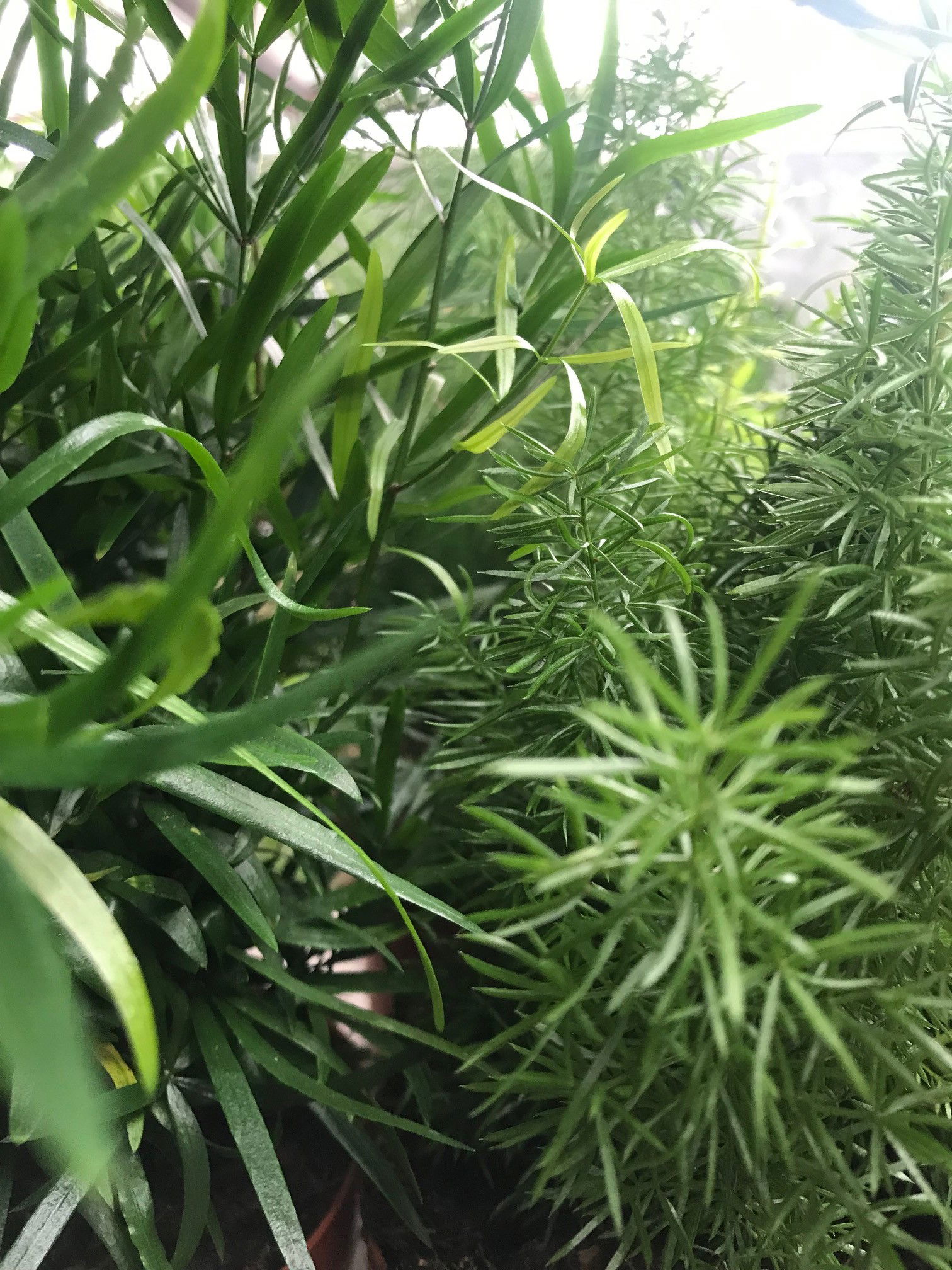
Asparagus densiflorus
Contents
- Top Tips
- Location, Water, Humidity & Fertilisation
- Common Issues
- Origins, Temperature, Propagation, Repotting & Toxicity.
Need the answer to a specific plant query? Book a 1-to-1 video call with THE HOUSEPLANT DOCTOR™, the website's friendly author, to overcome and address your niggling problem! Available on iMessage, WhatsApp, Facebook Messenger & more.
Top Tips & Info
- Care Difficulty - Easy to Moderate
- In terms of care requirements, we recommend a bright, indirect windowsill away from the sun as prolonged exposure will result in yellowed needles & even shedding. A north, north-east or north-west facing window or under grow light is best.
- Maintain evenly moist soil, allowing the top third to dry out in between waters.
- Fertilise using a 'Houseplant' labelled feed every third water in the spring and summer, reducing this to every four between mid autumn and early spring.
- Repot every three years with a 'Houseplant' labelled compost during the spring. Water the soil 24hrs before the transplant to reduce the chance of damaging small hairs found on the roots.
- Pests aren't usually an issue due to the delicate foliage, except for Fungus Gnats that may fly around its soil.
- If your Asparagus Fern becomes fully yellow and drops its foliage, hard prune the stems back to the soil line for fresh regrowth. Scroll down to 'Pruning & Maintenance' to learn more.
- Asparagus Ferns aren't actually ferns and instead form part of the Asparagaceæ family that holds plants like Agaves, Aspidistra (Cast Iron Plants) & Beaucarnea (Ponytail Palms). Once your plant reach maturity, they'll produce flowers & thicker tubers, instead of spores on their under-leaves like with traditional Pteridophytic Ferns.
Location & Light - 🔸🔸
Provide a bright, indirect location for best results. Never place a specimen in more than two hours of direct sunlight a day, due to the risk of foliage bleaching. In the winter, Asparagus Ferns can be situated in areas that provide a splash of morning sunlight, which in turn will reduce the risk of soil mould and root rot over this crucial period.
Avoid placing it within three metres of a south-facing window or operating radiators to prevent falling in the trap of persistent droughts.
Water - 🔸🔸
During the growing period, allow the soil's top third to dry out in between waters to dehydration. Persistent droughts will result in yellowed fronds that'll quickly shed its needles, resulting in a weakened, naked plant. Other under-watering symptoms include stunted growth and rapid needle loss; these issues are typically caused by intense sunlight or heat, being potbound or pure forgetfulness. If you're a constant under-waterer, consider relocating the plant to a slightly darker area to slow the drying of the soil. Over-watering, on the other hand, will lead to root or tuber rot, yellowing fronds and a decline of health. If mould begins to develop on the compost's surface, it could be the product of too much soil moisture and not enough light or air circulation.
Humidity - 🔸
Average room humidity is more than enough to satisfy this plant. Never situate it within a few metres of an operating radiator due to the enriched chance of browning frond-tips.
Fertilisation - 🔸
Fertilise your Asparagus Fern every third water whilst it's producing new shoots from its base, even if this is during the autumn or winter. While the plant isn't growing new foliage, be sure to fertilise it every fourth to fifth water, water using a 'Houseplant' labelled feed. You'll know if it's producing new shoots by checking the very base of the plant, usually around the soil line.
Note: If you're looking at enticing your Fern to produce new foliage, be sure to mist the leaves with 'Liquid Gold Leaf Photo+'.
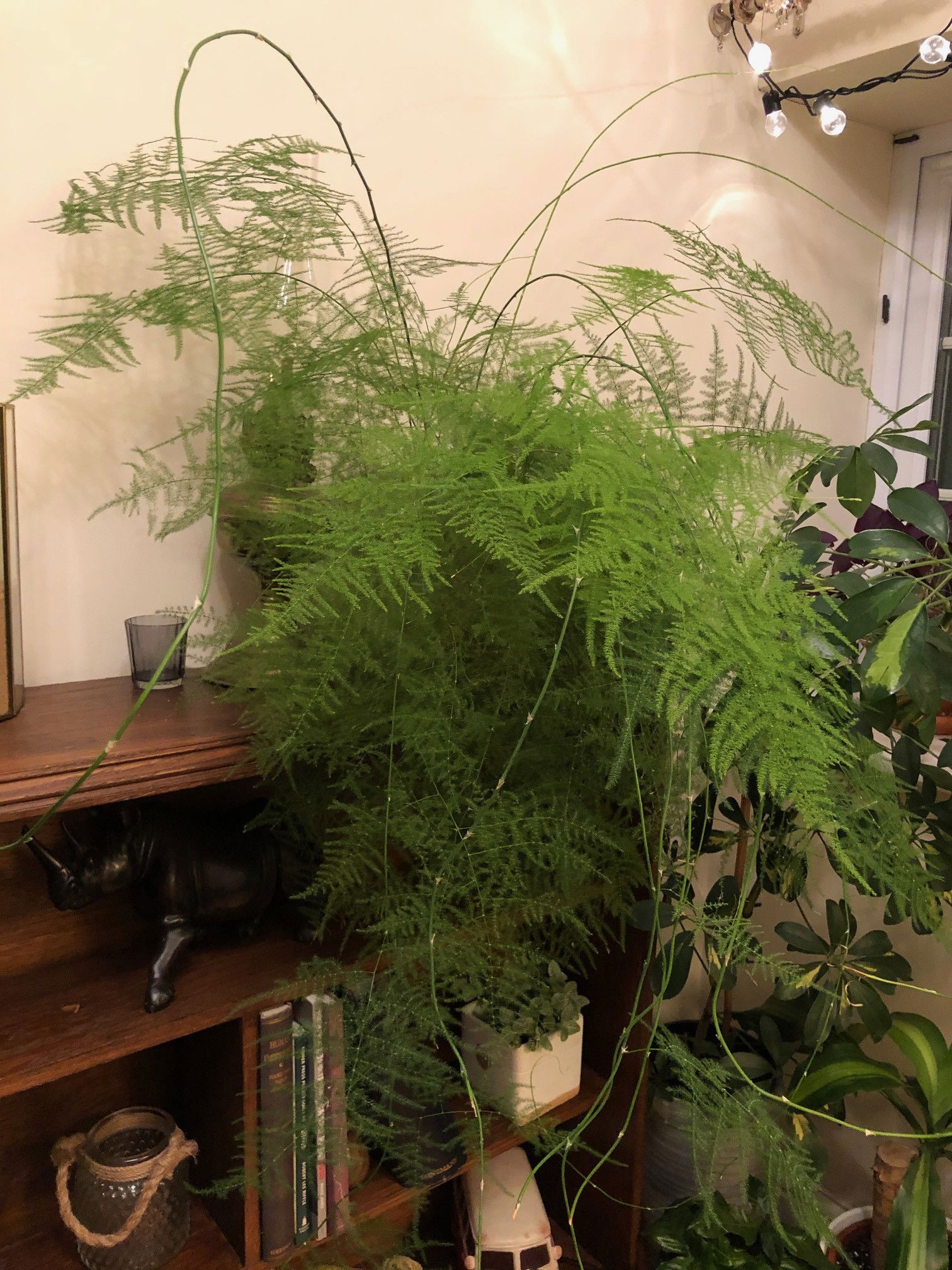 Expect a specimen of this size after six years, with new branches emerging from its base and pre-existing cladophylls (fronds).
Expect a specimen of this size after six years, with new branches emerging from its base and pre-existing cladophylls (fronds).
Common Issues with Asparagus Ferns
Yellow needles or fronds are a clear sign of dehydration, commonly caused by either intense sunlight or persistent droughts. Although the damaged foliage won't rejuvenate, new growth will quickly appear at the soil line if the growing conditions are improved. Avoid more than two hours of direct sunlight a day and allow the soil's top third to become dry in between waters. If all of the foliage has become yellow, scroll down to 'Pruning & Maintenance' to learn more on what to do.
Browning needles are also the direct product of dehydration, but it could also be caused by dry air. Situating an Asparagus Fern within a few metres of an operating radiator should be avoided at all costs; introduce a pebble/humidity tray to maintain a stable and moist air.
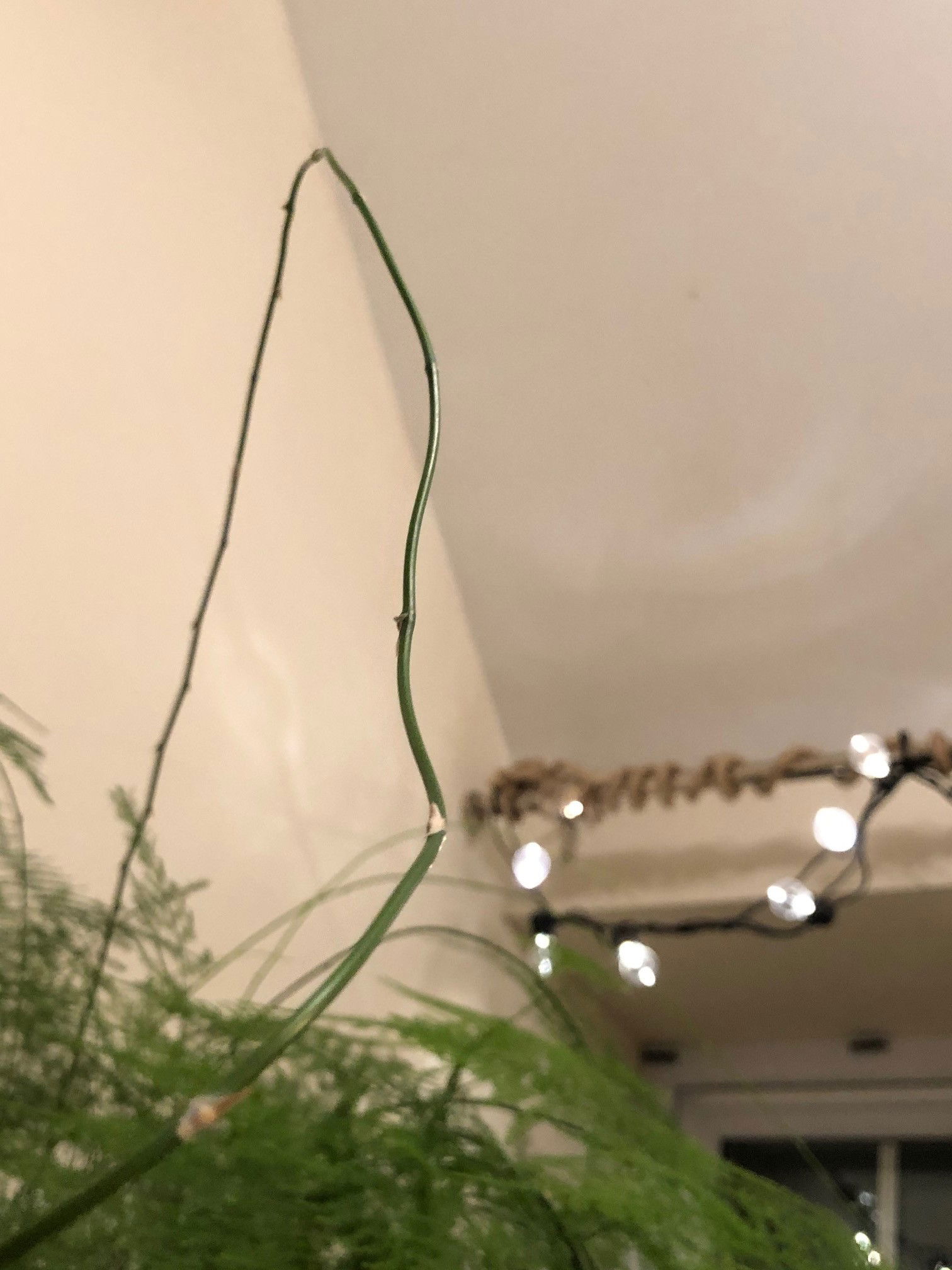 Asparagus Ferns will send out leafless stems to search for the light, but should develop foliage on them after a few months. If this phenomenon is making your plant look leggy, feel free to prune the leggy stems back to within the foliage (it should produce leaves afterwards).
Asparagus Ferns will send out leafless stems to search for the light, but should develop foliage on them after a few months. If this phenomenon is making your plant look leggy, feel free to prune the leggy stems back to within the foliage (it should produce leaves afterwards).
Root rot is a common issue among specimens sat in too dark environments with prolonged soil moisture. Symptoms include rapidly yellowing leaves, stunted growth and a rotten brown base. Take the plant out of the pot and inspect health below the soil line. If the roots sport a yellow tinge, you're good to go, but if they're brown and mushy, action must be taken immediately. More information about addressing root rot can be found on this link.
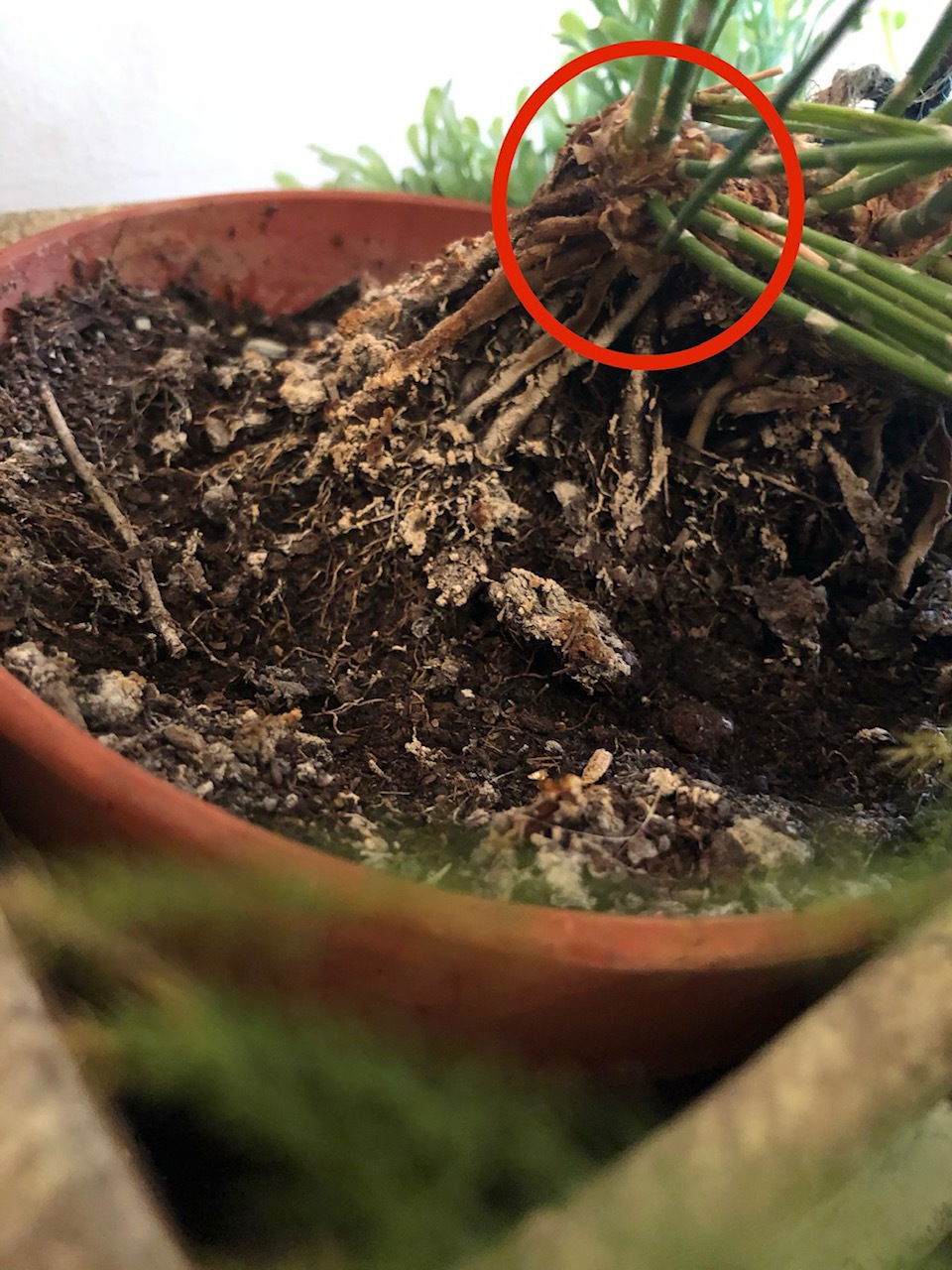 Asparagus Fern tubers are fleshy storage bulbs that house both its stems and roots (circled). Although soil mould is completely harmless, it's considered unsightly to most growers and can be removed by replacing the top two inches of soil with new 'Houseplant' labelled compost.
Asparagus Fern tubers are fleshy storage bulbs that house both its stems and roots (circled). Although soil mould is completely harmless, it's considered unsightly to most growers and can be removed by replacing the top two inches of soil with new 'Houseplant' labelled compost.
Origins
The genus, Asparagus, was first described by Carl Linnaeus in 1767, with its natural distributions across coastal regions of southern Africa. Its nickname, Sprenger's Asparagus Fern, was named after Carl Ludwig Sprenger, a German botanist who introduced the genus to European markets back in the late 19th century.
The Meaning of Species Names.
Asparagus setaceus or Lace Fern (1966) - Refers to the 'bristle--like thorns that develop along the stems.
A. densiflorus (1966) - Refers to the tightly-compacted flowers.
A. plumosa (1875) - Refers to the feather-like cladophylls. Symomous of A. setaceus.
 The distribution of Asparagus Ferns in Green, with artificial introduction highlighted in Red.
The distribution of Asparagus Ferns in Green, with artificial introduction highlighted in Red.
Temperature
12° - 26°C (54° - 80°F)
H1b (Hardiness Zone 12) - Can be grown outdoors during the summer in a sheltered location with temperatures above 12℃ (54℉), but is fine to remain indoors, too. If you decide to bring this plant outdoors, don't allow it to endure any direct sunlight as it may result in sun-scorch and dehydration. Regularly keep an eye out for pests, especially when re-introducing it back indoors.
Spread
Up to 2m (6ft) in height & 1m (3ft) in width. The ultimate height will take between 8 - 10 years to achieve, with several new stems produced per season from the tuberous base & cladophylls (fronds). Some Asparagus Ferns are climbers in the wild, so they may grow into a trailing plant instead of an upright plant (when you bought it).
Pruning & Maintenance (Information on Hard Pruning)
How & Where to Prune
Your Asparagus Fern may need a total 'reset' from time to time, especially if it has recently lost all of its foliage or is looking leggy. We recommend pruning the stems back to around an inch above the soil line to promote new shoots from the ground. Although it sounds drastic, this will majorly benefit your Fern in the long run as its priority will focus on regrowth instead of trying to hold on to its failing older leaves.
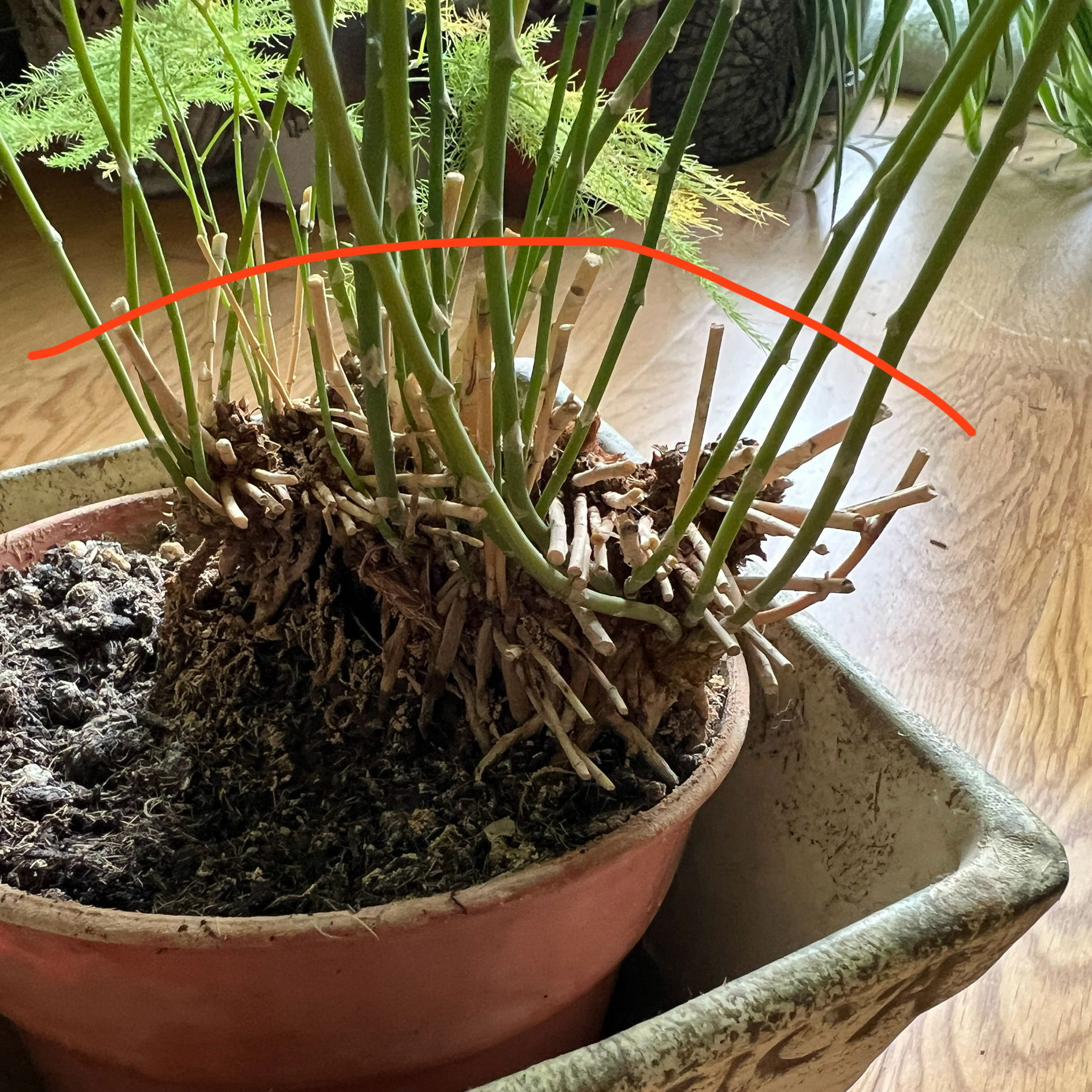 The red line digitally drawn shows exactly how far away from the soil you should cut when performing a hard prune.
The red line digitally drawn shows exactly how far away from the soil you should cut when performing a hard prune.
What to Do After Pruning & While the Plant is Leafless
Maintain a bright windowsill that provides temperatures above 18°C (64°F) throughout the recovery period. Keep the soil moist by using lukewarm water and feed every third hydration with a 'Houseplant' labelled fertiliser. Have a look at the image below of our fern that bounced back from a hard prune earlier in the year.
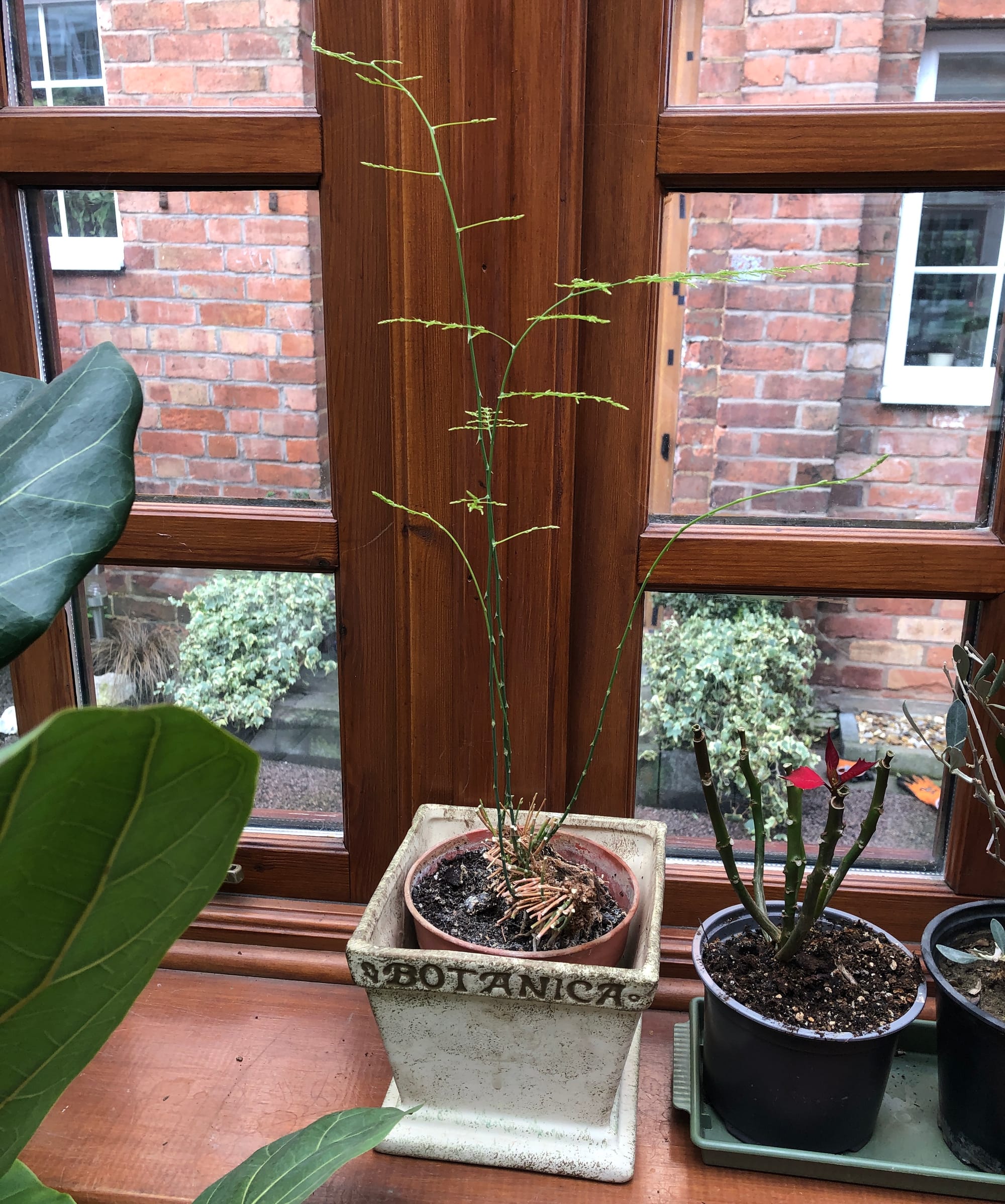 Our Asparagus Fern was looking a little tired and leggy with yellowing foliage. After pruning it back to the soil line, it produced these new shoots within three weeks!
Our Asparagus Fern was looking a little tired and leggy with yellowing foliage. After pruning it back to the soil line, it produced these new shoots within three weeks!
Propagation
Via Seeds or Tuber Division.
Tuber Division - Your plant will produce several tuberous offsets (similar to potatoes) that can be separated once they have a sufficient root system, and surpass 2cm (0.8 inches) in diameter. Water the soil 24hrs before the main event to reduce the risk of transplant shock - when its dry root systems are over-fingered. Take the plant out of its pot and place your fingers close to the nodal junction between the two tubers - soil may have to be removed for better access. Push the chosen offset downwards until you hear a snap. Separate the foliage and its root system away from the mother plant, mentally noting the high risk of damage. Transplant in the appropriate sized pot with a fresh batch of 'Houseplant' soil. Maintain evenly moist soil and situate it in a bright, indirect location away from any direct sunlight. After six weeks, treat it like a standard specimen, following the care tips above!
Flowers
It's rare for a domestically grown Asparagus Fern to bloom indoors due to the insufficient growing conditions. Out of the available species currently on the market, the A. densiflorus is mostly likely to flower in the spring.
Small, white or pink flowers will develop along the stems, providing a sweetly scented aroma that can last up to a week. If pollination is successful, the flowers will develop into red berries that are highly poisonous when ingested.
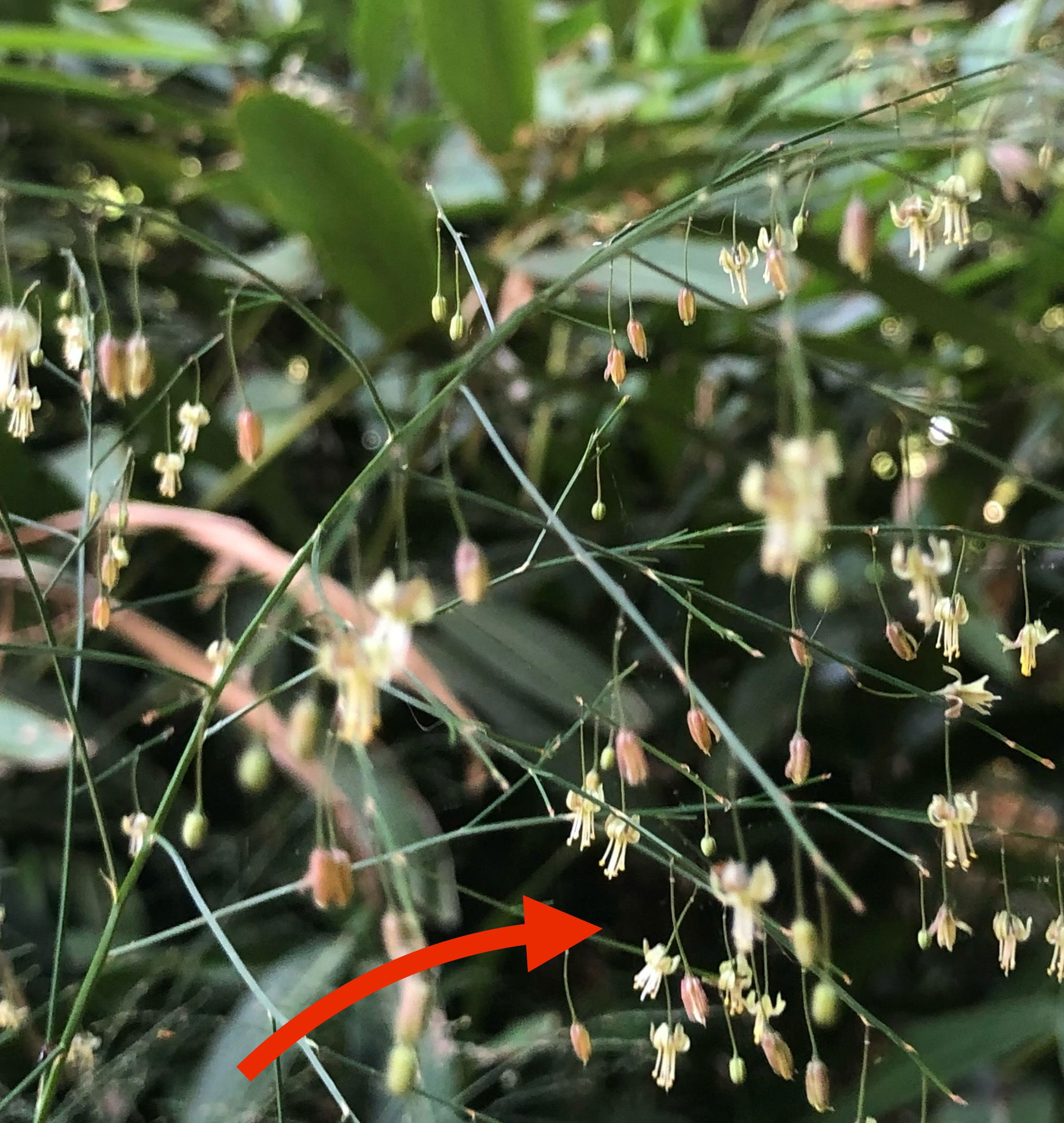 The flowers of an Asparagus Fern are small but are arranged in large clusters that hang over the foliage.
The flowers of an Asparagus Fern are small but are arranged in large clusters that hang over the foliage.
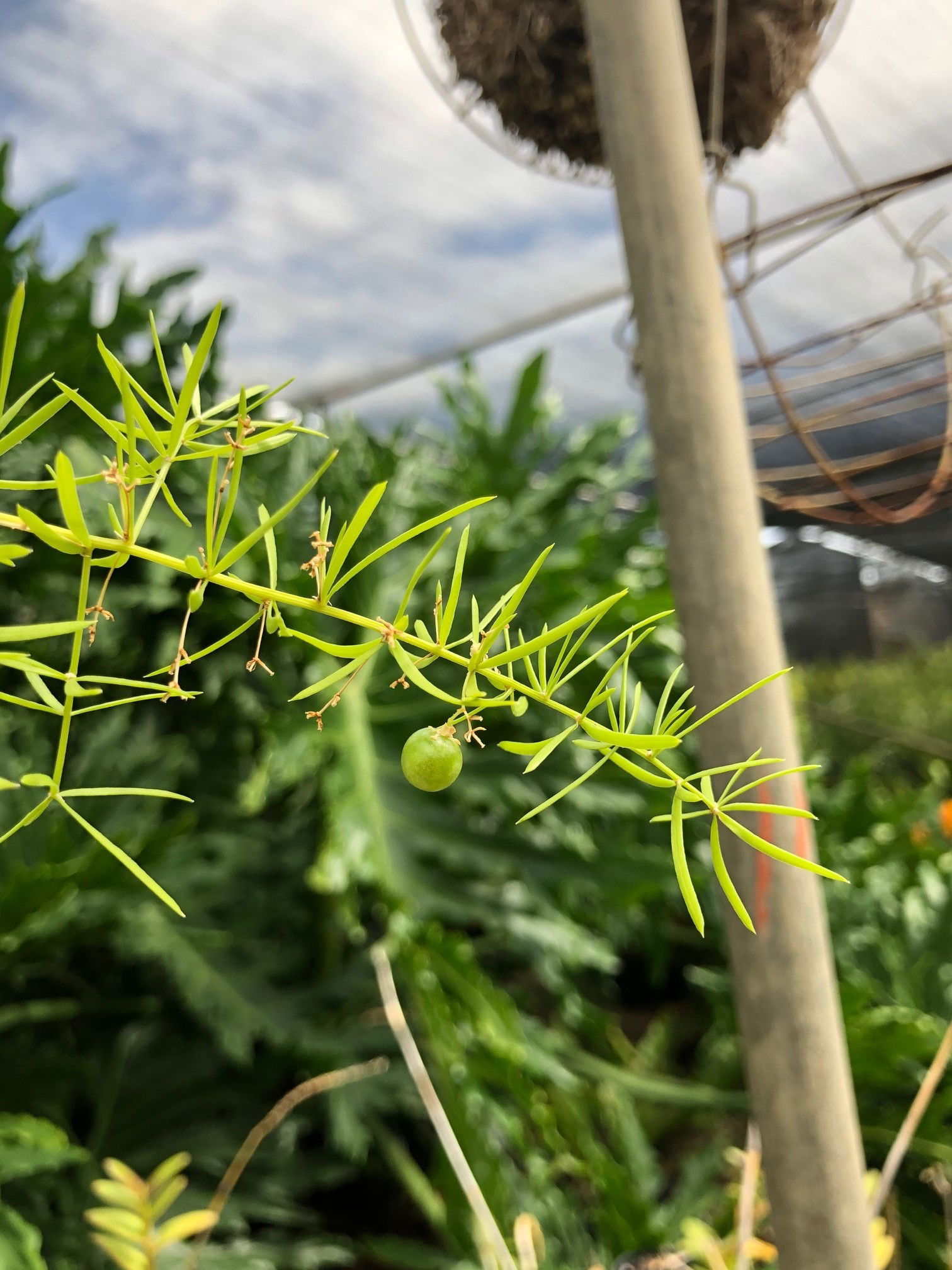
An unripe berry of the A. densiflorus (Foxtail Fern).
Repotting
Repot every two years in spring using a 'Houseplant' labelled compost and the next sized pot with adequate drainage. Hydrate the plant 24hrs before tinkering with the roots to prevent the risk of transplant shock. As the genus originates from temperate locations in Southern Africa, add a thin layer of small grit in the pot's base to improve drainage and strengthen the root's strength. Click here for a detailed step-by-step guide on transplantation, or via this link to learn about repotting with root rot.
Book a 1-to-1 video call with THE HOUSEPLANT DOCTOR™ if you'd like a personal guide to repotting your houseplant. This will include recommending the right branded-compost and pot size, followed by a live video call whilst you transplant the specimen for step-by-step guidance and answer any further questions!
Pests & Diseases
Keep an eye out for aphids, spider mites, blackfly & root mealybugs that'll locate themselves in the cubbyholes and undersides of the leaves, with the exception of the latter in the soil. Common diseases associated with Asparagus Ferns are root rot, botrytis, rust, powdery mildew & southern blight - click here to learn more about these issues.
Toxicity
The plant itself isn't poisonous; however, sharp thorns will develop via the stems, potentially becoming a skin irritant to some individuals. Once matured, they'll also produce white flowers & red berries that are highly poisonous to both pets and humans if ingested.
Retail Locations
Dobbies, British Garden Centres, Blue Diamond & Online Stores.
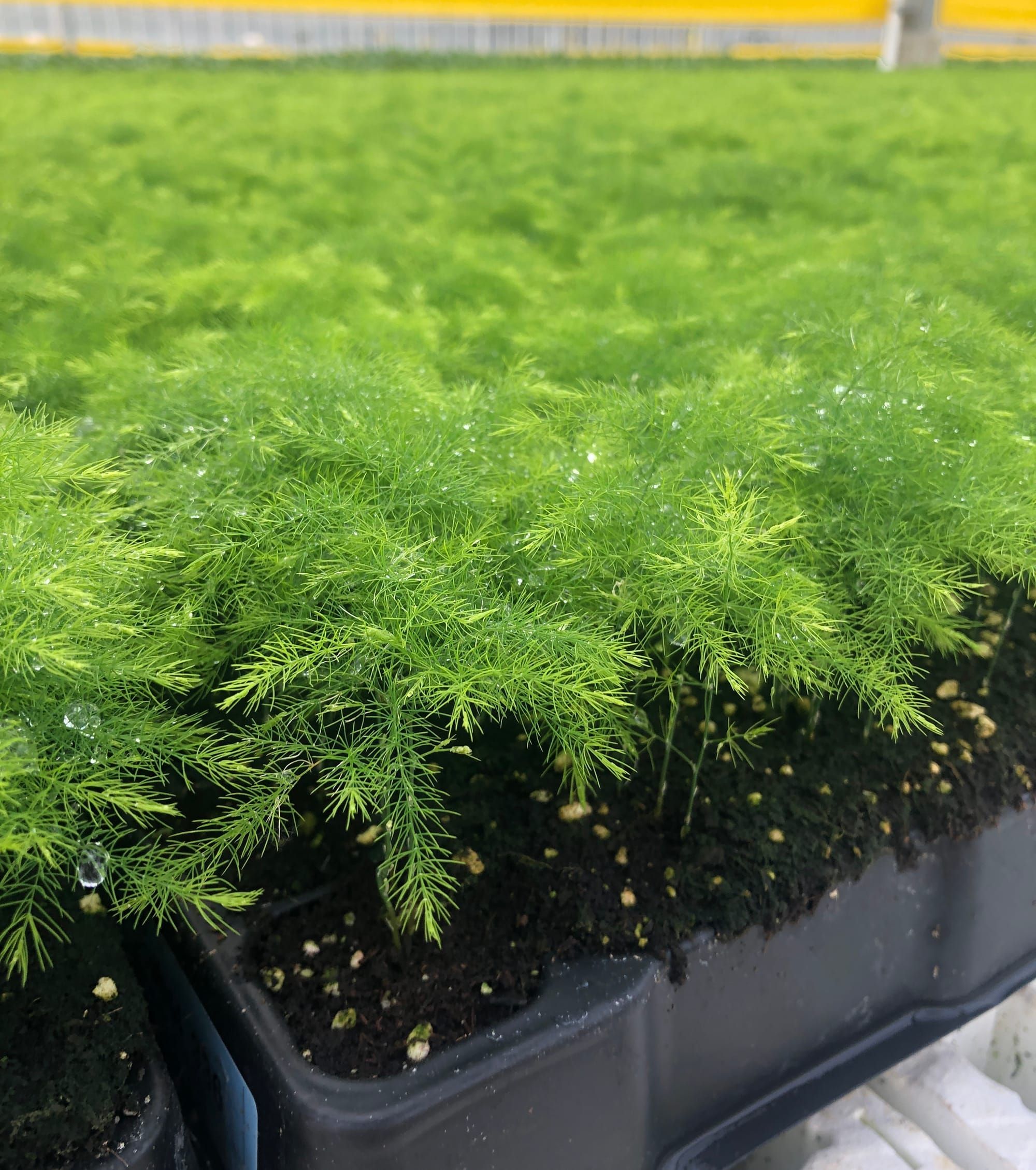 Extra Photo: Asparagus Ferns are commercially grown from seed, similarly to the Cheese Plant (Monstera) or Indoor Palm! The plants above are around six weeks old at this point.
Extra Photo: Asparagus Ferns are commercially grown from seed, similarly to the Cheese Plant (Monstera) or Indoor Palm! The plants above are around six weeks old at this point.
Book a 1-to-1 Call with THE HOUSEPLANT DOCTOR™
If you need further advice with your houseplants, book an advice call with ukhouseplants' friendly and expert writer today! This can be done via a video or audio call on most apps, including Facebook, FaceTime & Skype. A ten-minute call costs £5.99 (US$7), or £15.99 for thirty minutes. You can ask multiple questions, including queries on plants, pests, terrariums, repotting advice and anything in between. Please consider supporting this service to keep ukhouseplants thriving!